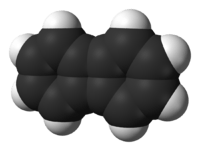Biphenylene
 | |
 | |
| Names | |
|---|---|
| IUPAC name
Biphenylene | |
| Other names
Diphenylene | |
| Identifiers | |
| 259-79-0 | |
| ChEBI | CHEBI:33079 |
| ChemSpider | 8859 |
| |
| Jmol-3D images | Image |
| PubChem | 9214 |
| |
| Properties | |
| C12H8 | |
| Molar mass | 152.19 g/mol |
| Appearance | solid |
| Melting point | 109 to 111 °C (228 to 232 °F; 382 to 384 K) |
| Related compounds | |
| Related unsaturated hydrocarbons |
benzene cyclobutene cyclobutadiene |
| Except where noted otherwise, data is given for materials in their standard state (at 25 °C (77 °F), 100 kPa) | |
| | |
| Infobox references | |
Biphenylene is an alternant, polycyclic hydrocarbon composed of two benzene rings joined together by a pair of mutual attachments (as opposed to a normal ring fusion), thus forming a 6-4-6 arene system. The resulting planar structure[1] was one of the first pi-electronic hydrocarbon systems discovered to show evidence of antiaromaticity.
The biphenylene structure can also be understood as a dimer of the reactive intermediate benzyne, which in fact serves as a major synthetic route, e.g., from benzenediazonium-2-carboxylate.[2]
Properties
Biphenylene, a pale yellowish solid with a hay-like odor, was first synthesized by Lothrop in 1941.[3] The chemistry of biphenylene is extensive, and has been the subject of two major reviews.,[4][5] Biphenylene is quite stable both chemically and thermally, and behaves in many ways like a traditional polycyclic aromatic hydrocarbon. However, both the spectral and chemical properties show the influence of the central [4n] ring, leading to considerable interest in the system in terms of its degree of lessened aromaticity.
Questions of bond alternation and ring currents have been investigated repeatedly. Both X-ray diffraction[6] and electron diffraction[7] studies show a considerable alternation of bond lengths, with the bridging bonds between the benzenoid rings having the unusually great length of 1.524 Å. The separation of the rings is also reflected by the absence of the transmission of NMR substituent effects through the central [4n] ring.[8] However, more sensitive NMR evidence, and particularly the shifting of proton resonances to high field, does indicate the existence of electron delocalization in the central [4n] ring.,[9][10] This upfield shift has been interpreted in terms of diminished benzenoid ring currents, either with or without an accompanying paramagnetic ring current in the central [4n] ring. Magnetic susceptibility measurements also show a diminishing of both diamagnetic exaltation and diamagnetic anisotropy, relative to comparable pure [4n+2] systems, which is also consistent with a reduction of ring current diamagnetism.[11][12] The electronic structure of biphenylene in the gas phase has the HOMO at a binding energy of 7.8 eV.[13]
Higher Biphenylenes
A fair number of higher polycycles containing the biphenylene nucleus have also been prepared, some having considerable antiaromatic character.[14][15][16][17][18] In general, additional 6-membered rings add further aromatic character, and additional 4-membered and 8-membered rings add antiaromatic character. However, the exact natures of the additions and fusions greatly affect the perturbations of the biphenylene system, with many fusions resulting in counter-intuitive stabilization by [4n] rings, or destabilization by 6-membered rings. This has led to significant interest in the systems by theoretical chemists and graph theoreticians.
References
- ↑ Waser, Jurg; Lu, Chia-Si (1944). "The Crystal Structure of Biphenylene". J. Am. Chem. Soc. 66 (12): 2035–2042. doi:10.1021/ja01240a012.
- ↑ Logullo, F. M.; Seitz, A. M.; Friedman, L. (1968). Org. Synth. 48. p. 12. Missing or empty
|title=(help) - ↑ Lothrop, W. C. (1941). J. Am. Chem. Soc. 63: 1187. doi:10.1021/ja01850a007. Missing or empty
|title=(help) - ↑ Cava, M. P.; Mitchell, M. J. (1967). "10". Cyclobutadiene and Related Compounds. Academic Press. pp. 255–316.
- ↑ Barton, J. W. (1969). "2". In J. P. Snyder. Nonbenzenoid Aromatics 1. Academic Press. pp. 32–62.
- ↑ Fawcett, J. K.; Trotter, J. (1966). Acta Crystallogr. 20: 87. Missing or empty
|title=(help) - ↑ Yokozeki, A.; Wilcox Jr., C. F.; Bauer, S. H. (1974). J. Am. Chem. Soc. 96: 1026–1032. doi:10.1021/ja00811a014. Missing or empty
|title=(help) - ↑ Sheffy, Forrest K. (1982). (Thesis). Cornell University. Missing or empty
|title=(help) - ↑ Katritzky, A. R.; Reavill, R. E. (1964). Recl. Trav. Chim. Pays-Bas 83: 1230. Missing or empty
|title=(help) - ↑ Fraenkel, G.; Asahi, Y.; Mitchell, M. J.; Cava, M. P. (1964). "NMR spectroscopy of benzocyclobutene and biphenylene". Tetrahedron 20 (5): 1179–1184. doi:10.1016/s0040-4020(01)98985-9.
- ↑ Dauben, Jr., Hyp. J.; Wilson, James D.; Laity, John L. (1969). J. Am. Chem. Soc. 91: 1991. doi:10.1021/ja01036a022. Missing or empty
|title=(help) - ↑ Anet, F. A. L.; Schenck, G. (1971). J. Am. Chem. Soc. 93: 556. doi:10.1021/ja00731a061. Missing or empty
|title=(help) - ↑ Lüder, Johann; de Simone, Monica; Totani, Roberta et al. (2015). "The electronic characterization of biphenylene—Experimental and theoretical insights from core and valence level spectroscopy". J. Chem. Phys. 142: 074305. doi:10.1063/1.4907723.
- ↑ Wilcox, Jr., Charles F.; Uetrecht, J. P.; Grohman, K. K. (1972). "Cycloocta[def]biphenylene". J. Am. Chem. Soc. 94 (7): 2532. doi:10.1021/ja00762a068.
- ↑ Wilcox, Jr., Charles F.; Farley, Erik N. (1983). "Dicycloocta[1,2,3,4-def:1',2',3',4'-jkl]biphenylene. Benzenoid Atropism in a Highly Antiaromatic Polycycle". J. Am. Chem. Soc. 105 (24): 7191–7192. doi:10.1021/ja00362a040.
- ↑ Wilcox, Jr., Charles F.; Farley, Erik N. (1984). "Dicyclooctabiphenylene. Synthesis and Properties". J. Am. Chem. Soc. 106 (23): 7195–7200. doi:10.1021/ja00335a055.
- ↑ Wilcox, Jr., Charles F.; Farley, Erik N. (1985). "Cyclooctannelated Biphenylenes. Diagnosis of an Anomalous Bond Length by Analysis of Ring Current Geometric Factors". J. Org. Chem. 50 (3): 351–356. doi:10.1021/jo00203a013.
- ↑ Farley, Erik Neil (1984). Dicyclooctabiphenylenes (Thesis). Cornell University.